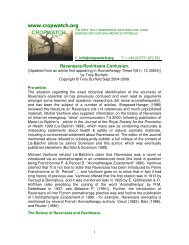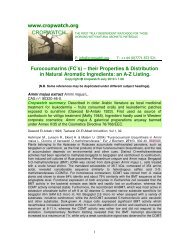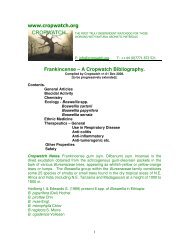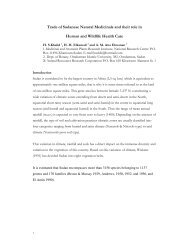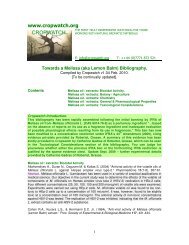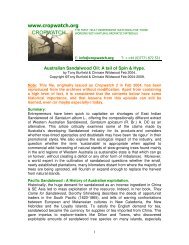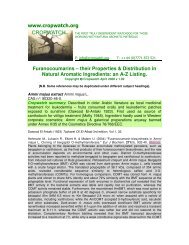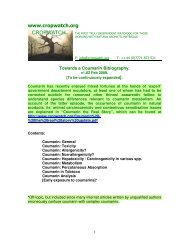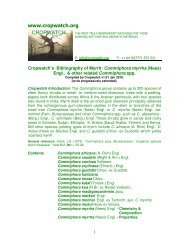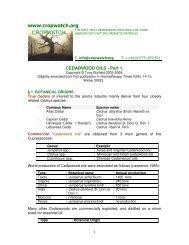Sandalwood Biblio - Cropwatch
Sandalwood Biblio - Cropwatch
Sandalwood Biblio - Cropwatch
Create successful ePaper yourself
Turn your PDF publications into a flip-book with our unique Google optimized e-Paper software.
distribution of male and female trees in O. lanceolata supporting stands and whether this has any<br />
significance in influencing the reproductive success; to document the phenological events<br />
occurring between flower initiation and fruit ripening; to examine the reproductive success of<br />
various stages through pollination experiment; and to assess the regeneration mode and potential<br />
of the species. The study revealed that, the distribution of male and female trees in most<br />
populations was random with no evidence of sex clustering. It takes 104 days from flowering until<br />
when 25% of fruit initiated become ripe. About 75% of the initiated fruits become ripe in 163 days.<br />
This study has also demonstrated absence of agamospermy behaviour in O. lanceolata. A limited<br />
reproductive success was noted however, due to either low level of pollen production or limited<br />
pollinators\' movement. Assisted pollination significantly increased the reproductive success of<br />
the species. The tree regenerates through seeds, rootstocks and coppice. Of the total<br />
regenerating plants assessed at sapling stage, 61% had originated from rootstock or coppice<br />
while 39% came from seed source. It is concluded that, recruitment of the species relies mainly<br />
on rootstock or coppice source although the importance of seeds cannot be ignored. Thus<br />
uprooting of the species as a mode of harvesting has to be discouraged since the practice is<br />
likely to severely limit the recruitment rate.<br />
Srikrishnaa A. & Beeraiah B. (2005) "First synthesis of (′)-tenuifolene and ar-tenuifolene." Indian J<br />
of Chemistry Sect B. 44(8), 1641-1643. Abstract. First total synthesis of the sesquiterpenes (′)-<br />
tenuifolene and (′)-ar-tenuifolene, isolated from the essential oil of the East African sandalwood<br />
tree Osyris tenuifolia, has been accomplished.<br />
Teklehaimanot Z., Mwang ingo P. L., Mugasha A. G. & Ruffo, C. K. (2004) "Influence of the origin<br />
of stem cutting, season of collection and auxin application on the vegetative propagation of<br />
African <strong>Sandalwood</strong> (Osyris lanceolata) in Tanzania." Southern African Forestry Journal 201, 13-<br />
24. Abstract. An investigation into the possibility of propagating O. lanceolata through stem<br />
cutting was carried out at Tanzania Tree Seed Agency, Iringa Zone, Tanzania. The aim was to<br />
test the potential of stem cuttings in providing an alternative/supplement to the use of seeds that<br />
are constrained with germination and storage problems. Three treatments were investigated on<br />
the rooting success and subsequent nursery performance of the cuttings: the effect of season at<br />
which cuttings are collected i.e. December, February, June and September; the effect of origin of<br />
stem cutting in a shoot, i.e. basal and terminal portions; and the effect of different levels of IBA as<br />
root promoters, i.e. 0, 50, 100 and 150 ppm. The results revealed that stem cuttings collected<br />
from the sprouting stumps have a potential to be used in propagating O. lanceolata. Season at<br />
which cuttings are collected; origin of the stem cuttings in a shoot and application of auxins<br />
influenced the rooting success. Stem cuttings collected in September, originating from the basal<br />
portion had the best rooting (43.8 + 3.9%). This is possibly related to the high levels of stored<br />
food in the plant after undergoing active photosynthesis during the rain season, November-May.<br />
Auxin application in interaction with the season at which cuttings were collected enhanced the<br />
number of cuttings that rooted, the number of roots formed (13 + 0.4), the length (14 + 0.3 cm)<br />
and biomass of roots (6.95 + 3.9 g) produced. The concentration to be applied for effective<br />
rooting depended on the season at which cuttings were collected. Of the origin of stem cuttings,<br />
basal portions had better rooting than the terminal portion. The high nutrition status and low<br />
nitrogen content of basal portions may play a role in enhancing their performance. Thus when<br />
raising O. lanceolata from stem cuttings, best rooting is obtained from those raised between June<br />
and September using cuttings from the basal origin of the juvenile shoots. Application of IBA<br />
between 50 and 100 ppm further enhances rooting success.<br />
Wells R. (2006) "On the scent: Rhona Wells investigates sandalwood poaching, the ugly<br />
downside of the luxurious natural perfumery raw material trade" Soap, Perfumery & Cosmetics<br />
Feb 2006 79(2), 31. <strong>Cropwatch</strong> comments: Informative one-page article on the Tanzanian<br />
situation where sandalwood logs are smuggled to India for distillation to produce sandalwood oil.<br />
Yeboah E.M.O., Majinda R.R.T., Kadziola A. & Muller A. (2010) "Dihydro-β-agarofuran<br />
Sesquiterpenes and Pentacyclic Triterpenoids from the Root Bark of Osyris lanceolata." J Nat<br />
26





